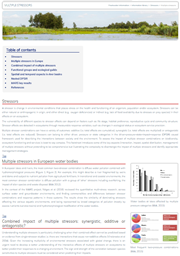What are stressors?
A stressor is change in environmental conditions that places stress on the health and functioning of an organism, population and/or ecosystem. Stressors can be either natural or anthropogenic in origin, and either direct (e.g. oxygen deficiencies) or indirect (e.g. lack of food availability due to stresses on prey species) in their effects.
The vulnerability of different species to stressor effects can depend on factors such as life stage, habitat preference, reproductive cycle and community structure. Stressor effects are detected in ecosystems through measurable response variables such as changes in ecological status or ecosystem service provision.
Stressors often occur in combination (multiple stressors) and can have variable outcomes: additive (i.e. total effects are cumulative); synergistic (i.e. total effects are multiplied) or antagonistic (i.e. total effects are reduced). Stressors can belong to either the pressure or state category in the driver-pressure-state-impact-response (DPSIR) causal framework used for describing the interactions between society and the environment.
Below the five main stressor groups are presented and will be described in further detail.
References
Kristensen, P. (2004). The DPSIR Framework (Download report, 0.5mb)




